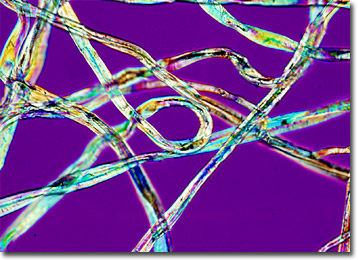Polarized Light Microscopy Digital Image Gallery
Cotton Fibers
Cotton is a vegetable fiber that comes from the seed capsules, or bolls, of an array of plants in the genus Gossypium of the family Malvaceae. Native to most subtropical areas, it has been cultivated, as well as spun and woven into textiles, for thousands of years in civilizations that span the globe.

In modern times, cotton remains one of the most important fibers in the world, despite the increasing number of synthetic fibers being developed. Indeed, technological advances, the most important of which may be considered Eli Whitney’s cotton gin invented in 1793, have made it more economical to produce than ever before and the development of special treatment processes have resulted in stain, wrinkle, and water resistant varieties of the fiber. Moreover, a better understanding of advantageous farming techniques as well as the availability of insecticides that help eradicate the dreaded boll weevil and other crop pests have ensured cotton’s widespread abundance.
Cotton fiber is utilized to produce a seemingly boundless range of products and commodities. It has, however, historically been most popular as a material for clothing and other textiles due to its softness, absorbency, strength, and dyeability, as well as the ease with which it may be cared for. More recently, many of these same qualities have been responsible for cotton’s introduction into such products as paper, cardboard, medical supplies, plastics, and tire cord. Cottonseed and the oil pressed from it are also in great demand around the world, finding use in a wide assortment of items including cosmetics, margarines, shortenings, and paints.
